|
Printables |
PowerPoints |
Online exercises |

|
A1+-A2 Who, whose, which & what practise
Learning who, whose, which, and what enhances student�s ability to ask precise questions and provide clear information, especially regarding people, ownership, and specific choices. Who identifies people, whose indicates possession, which offers choices, and what gathers open-ended information. Mastering these words improves communication, making y...
Level: elementary
Age: 8-100
Type:
Downloads: 119
|
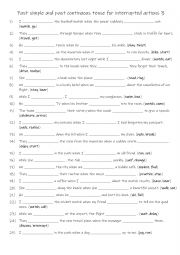
|
A1+-A2 Past simple and past continuous tense for interrupted actions 3
Learning the past simple and past continuous tenses for interrupted actions is essential because they help students describe events that were happening in the past when something else occurred. The past continuous is used to show the action that was in progress at a specific time in the past, while the past simple is used to describe the action tha...
Level: elementary
Age: 8-100
Type:
Downloads: 119
|
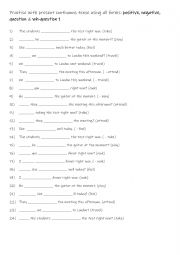
|
A1-A1+ Practise with present continuous tense using all forms positive, negative, question & question word with question 1
Learning the Present Continuous Tense in all its forms (positive, negative, question, and question word) is vital for effective communication in English. It enables students to describe actions happening at the moment, express temporary situations, and discuss future arrangements. Mastering the tense also allows for the formation of questions, help...
Level: elementary
Age: 8-100
Type:
Downloads: 119
|
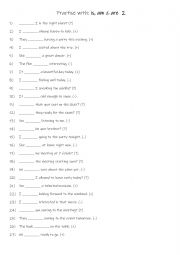
|
A1 Practise with is, am & are 2
Students read the sentence and complete the sentence with the correct form of the verb to be. They use the (+) or (-) sign at the end of the sentence to see if it needs a positive or negative form of the verb to be. Each form is used 3 times! Answers on page 2.
Level: elementary
Age: 7-8
Type:
Downloads: 119
|
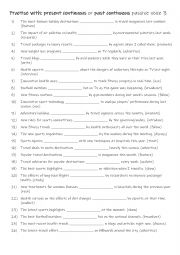
|
A2-B1 Practise with present continuous or past continuous passive voice 3
These tenses enhance precision and fluency when talking about the future. First, students need to familiarise themselves with the 2 tenses and their use. Then they read the sentences to work out which one is needed to complete the gap-fill. Each adverb is used 13 times! Answers on page 2
Level: elementary
Age: 10-100
Type:
Downloads: 119
|
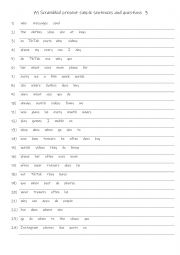
|
A1 Scrambled present simple sentences and questions 3
Practising scrambled present simple sentences and questions helps students understand correct word order, including subject-verb agreement and the use of auxiliaries in negatives and questions. It enhances their grammatical accuracy, boosts critical thinking as they rearrange words meaningfully, and improves their ability to form sentences quickly ...
Level: elementary
Age: 6-100
Type:
Downloads: 119
|
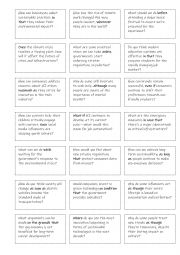
|
B2-C1 Conjunctions with 42 questions
First, students need to familiarise themselves with the 42 linking words and their meanings. Then in pairs or small groups they discuss the questions.
Level: advanced
Age: 14-100
Type:
Downloads: 119
|
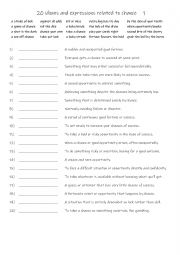
|
B1+-C1 Chance idioms and expressions 1
First, students need to familiarise themselves with the 20 idioms and expressions and their meanings. Then they read the definitions to see which one is being described and write that word in the space provided Answers on page 2.
Level: intermediate
Age: 12-100
Type:
Downloads: 119
|
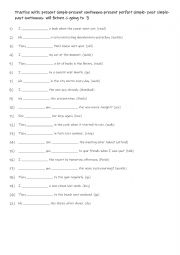
|
A2+-B1 Practise with present simple-present continuous-present perfect simple- past simple-past continuous- will future & going to 3
These tenses help students describe routines, ongoing events, past experiences, and future plans clearly and accurately. Mastery of these tenses improves communication, making it easier to talk about the present, past, and future in both every day and professional contexts. First, students need to familiarise themselves with the tenses and use. The...
Level: elementary
Age: 8-100
Type:
Downloads: 119
|
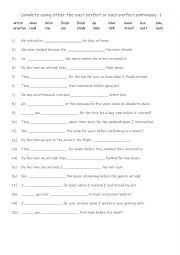
|
Complete using either the past perfect or past perfect continuous 1
First, students need to familiarise themselves with the 2 tenses and their use. Then they read the sentences to see which tense is needed to complete the sentence. Each tense is used 10 times! Answers on page 2.
Level: intermediate
Age: 9-100
Type:
Downloads: 119
|
|
|
|
|












